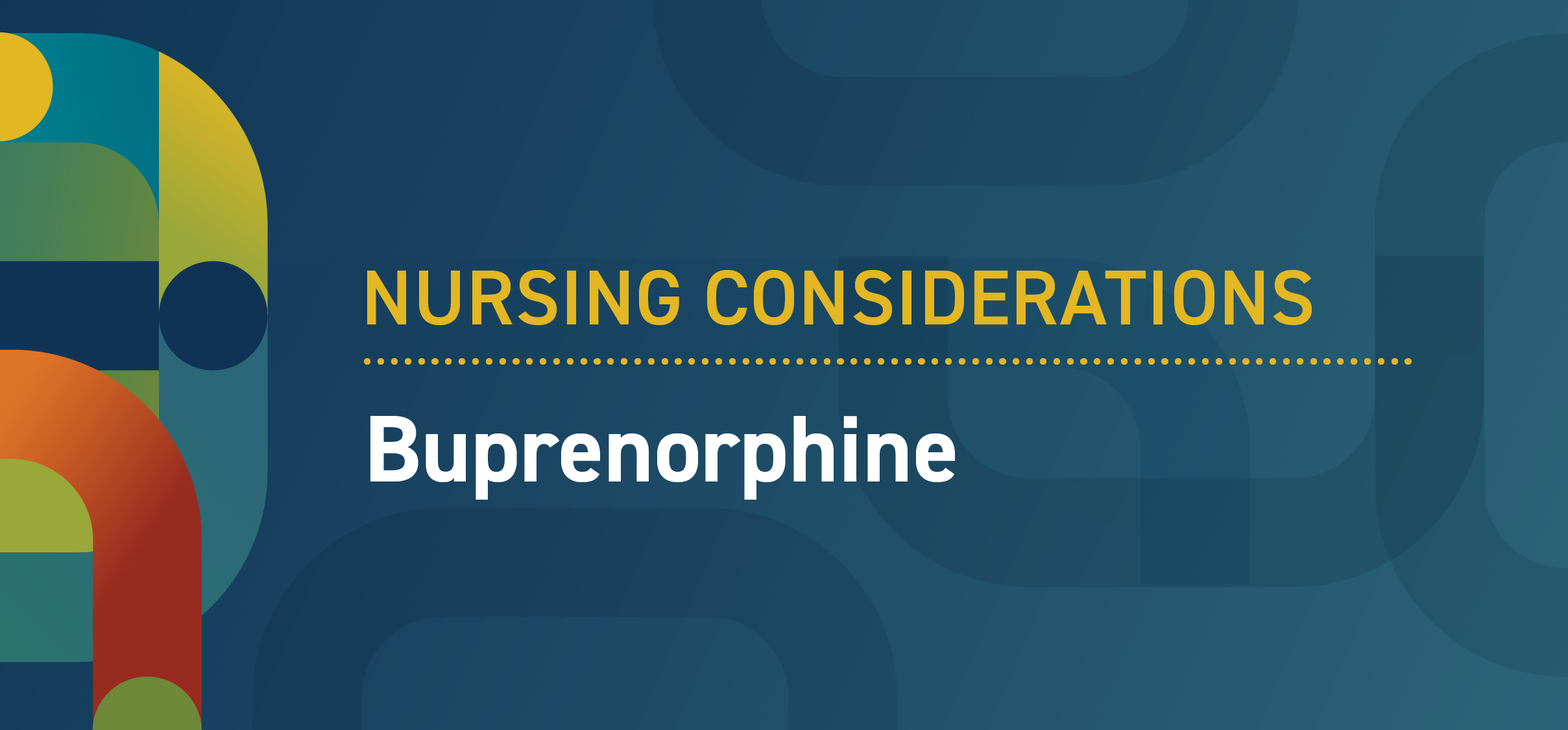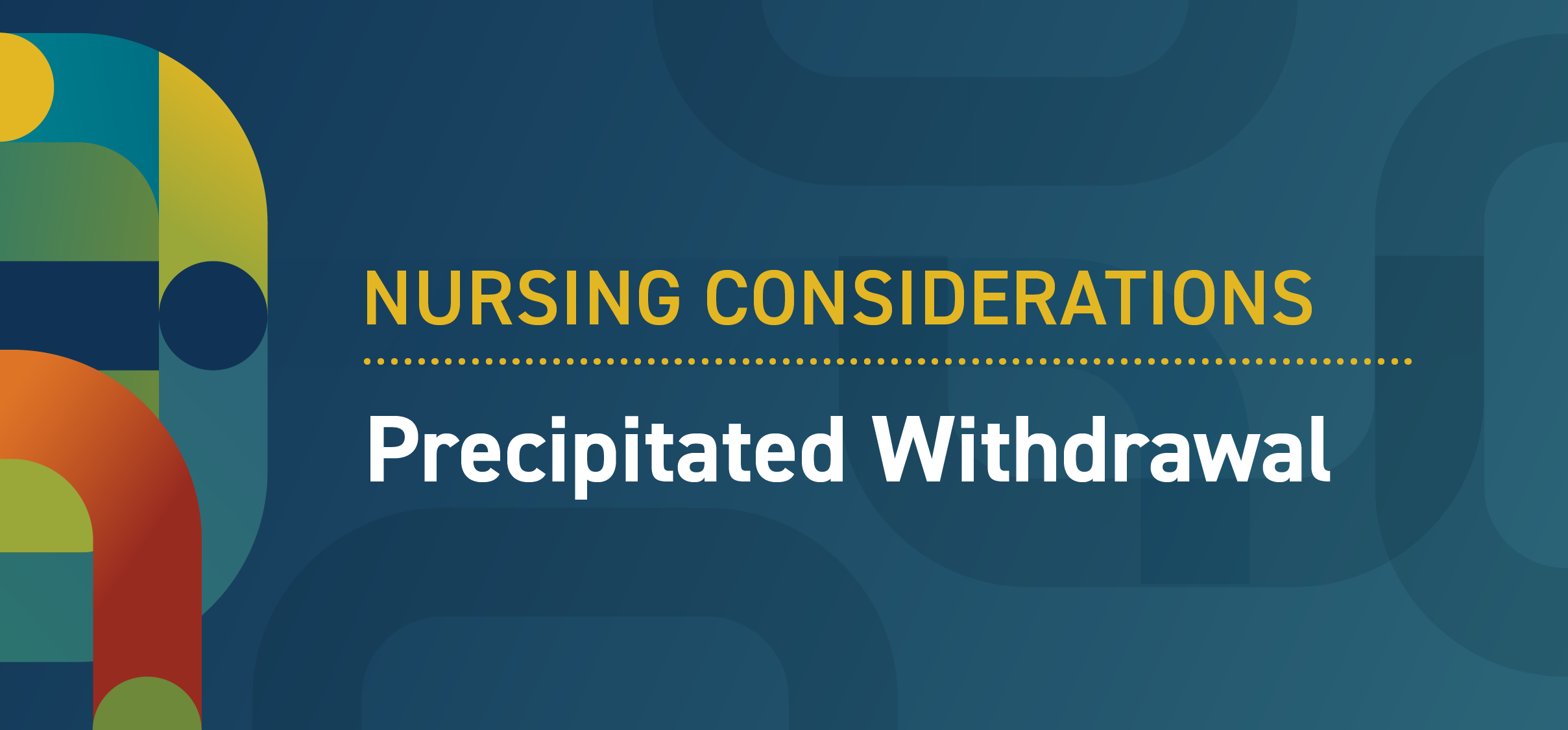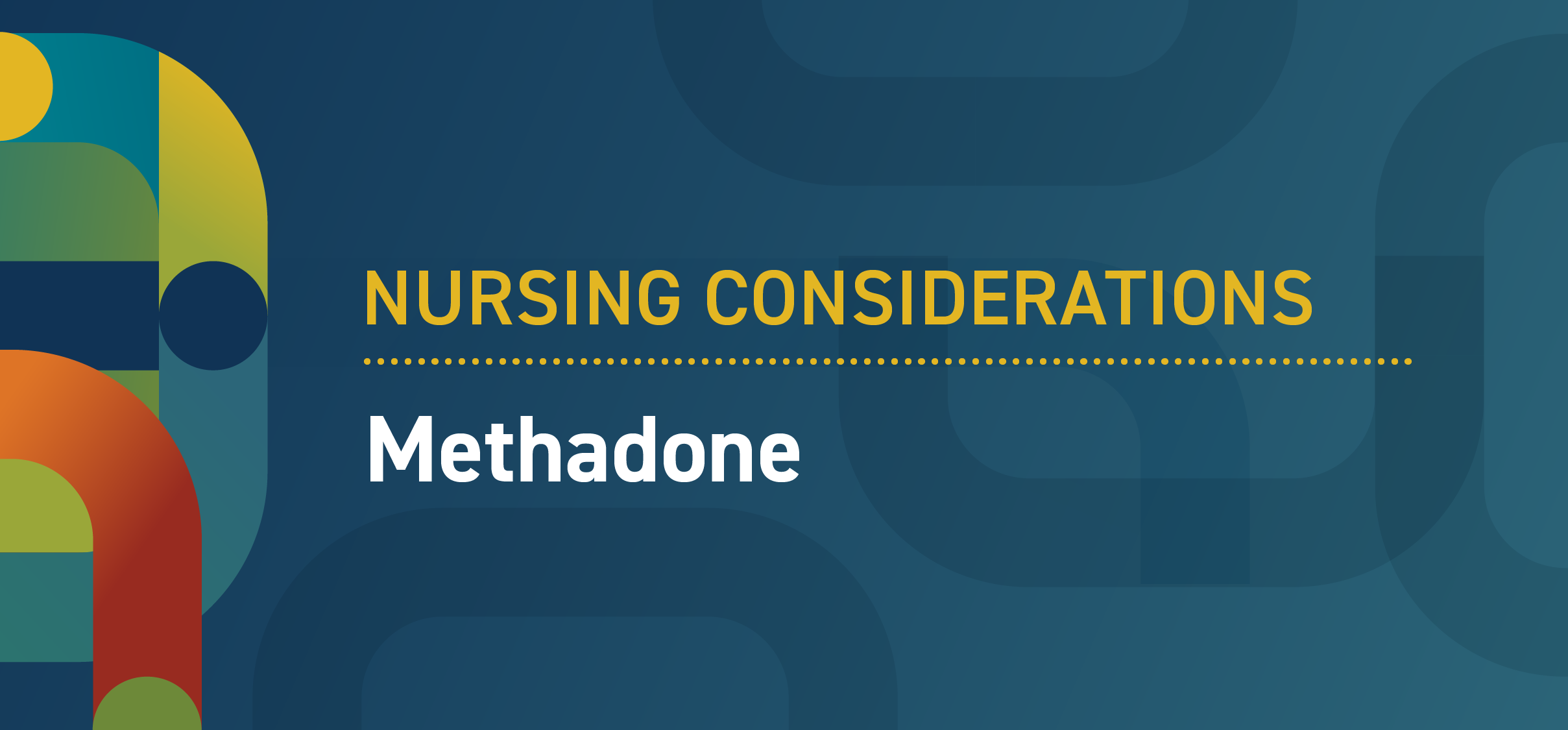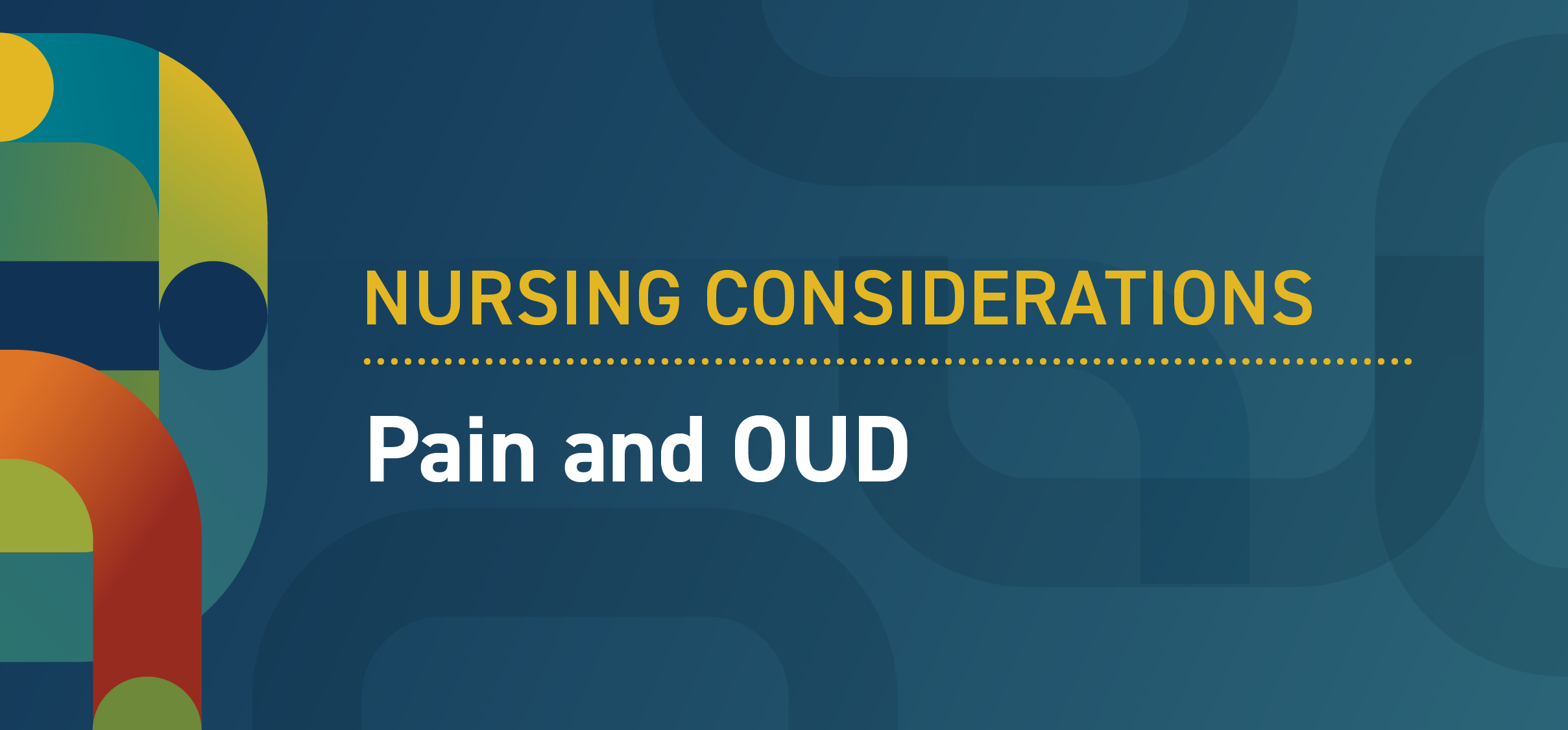FOR NURSING
Nursing considerations - buprenorphine

Background
- Buprenorphine is a life-saving medication; it significantly reduces the risk of all-cause mortality and overdose death for people with opioid use disorder (OUD).
- Buprenorphine is a partial opioid agonist that helps to minimize withdrawal and lessen opioid cravings and use.
- Because it is a partial agonist, if the first dose of buprenorphine is administered too soon after recent full agonist opioid use in a patient with opioid dependence, there is a risk of precipitated withdrawal, which is a sudden worsening of withdrawal symptoms after buprenorphine administration. If this happens, additional doses of buprenorphine and medications for alleviating withdrawal symptoms should be administered immediately as ordered.
- Doses of 16-24mg daily are considered most effective for most patients. Doses should be adjusted based on symptoms— if they are having ongoing cravings to use, a dose increase should be considered.
- Withdrawal can be excruciating; patients are at high risk of returning to their regular opioid use during this time without adequate intervention and support.
- Patients commonly need adjunct medications to control withdrawal symptoms until they stabilize on the medication.
- If taken with other sedative substances (CNS depressants) buprenorphine can cause respiratory depression. People should not increase their dose of other sedative medications, drink more than their usual amount of alcohol, or use other drugs while starting buprenorphine.
- Patients may need to take a day off from their regular activities while adjusting to the medication.
- Buprenorphine is safe and there is no limit to how long a person can take the medication. It is recommended that most people be on the medication long-term.
- When taken as directed, buprenorphine helps people with opioid use disorder get out of the cycle of use and withdrawal, feel more stable, and have a chance to focus on other aspects of their lives so they can recover.
- When used as prescribed, buprenorphine significantly reduces the risk of opioid overdose if the patient takes other opioids.
- Opioid use disorder is a treatable health condition. It often takes multiple treatment attempts for patients to recover. Stopping substance use is extremely challenging. Patients should be supported regardless of how many times they ask for help. Even the most severe cases do recover.
- Patients with OUD or other substance use disorders experience a great deal of stigma and often have high levels of anxiety related to previous negative healthcare experiences. Research shows that stigma, bias, and even perceived judgement worsens symptoms and prolongs recovery. It’s vital to treat patients in a caring and supportive manner.
- Hospitals in Washington are required to hand naloxone (not a prescription) to people with OUD or those who are otherwise at risk of opioid overdose.
Actions
- Assess a COWS score prior to administration. Do not administer if the patient does not have signs of withdrawal.
- Inform the patient of the risk of precipitated withdrawal. Ask them to let you know right away if their symptoms get worse and reassure them you will treat them right away if that happens.
- Administering buprenorphine or buprenorphine-naloxone:
- The medication comes in both film and tablet form. Both forms are to be taken sublingually. The medication is not absorbed well in the stomach, so they must take it correctly to receive the benefit of the medication.
- The patient must let the medication dissolve fully under the tongue. This can take 5 to 10 minutes, sometimes longer. Drinking water prior to administration can help it dissolve faster. Many find the taste of the medication unpleasant. One way to know that the medication is dissolved and absorbed is when the taste goes away.
- Patients should not eat, drink, or talk while the medication is dissolving.
- To prevent oral decay, instruct the patient to rinse their mouth with water 30 minutes after administration.
- If the patient endorses continued withdrawal the reported symptoms should be treated with the appropriate adjunct medication as ordered.
- Reassess within 30 minutes. If the patient is experiencing precipitated withdrawal treat it immediately.
- Monitor patients for signs of respiratory depression and educate patients about the risk of overdose and death when using buprenorphine-naloxone with other sedating drugs, such as alcohol or benzodiazepines.
Discharge planning
- Help the patient schedule a follow-up appointment.
- Ensure the patient is provided with a buprenorphine prescription to last until their scheduled outpatient MOUD appointment. If there is not an appointment scheduled, provide at least 7-14 days to allow time for the patient to secure an appointment.
- If the patient needs adjunct withdrawal management medications, ensure they are provided with scripts to last at least 7 days.
- Provide the patient with discharge instructions that include time of last dose, and when to take the next dose. Ensure patient understands importance of taking the medication every day at about the same time.
- Educate the patient on the correct administration of the medication. Ensure the patient understands that buprenorphine is taken under the tongue and is not absorbed in the stomach; it can take 5 to 10 minutes for the medication to fully absorb, and that the patient should avoid eating, drinking, smoking, or talking while taking buprenorphine-naloxone.
- Educate the patient on the risks of taking other sedatives.
- Provide a work note if needed. They should not drive or operate heavy machinery until they are used to the medicine.
- Ensure patient is discharged with naloxone. Provide overdose prevention education. Ensure patient is aware that changes in use patterns can alter tolerance and increase risk of opioid overdose.
Overdose prevention patient education
Using street drugs is risky. If you do use, reduce your risk of dying from an opioid overdose with the following:
- Naloxone
- Today you received naloxone or a prescription for naloxone. This is an opioid overdose reversal medication. It is safe to use on anyone you suspect is experiencing an opioid overdose. Visit stopoverdose.org or talk to your provider, nurse, or pharmacist to learn more.
- If someone is unresponsive or has unusual or no breathing, call 911 and give them naloxone and rescue breaths.
- Tell others you have naloxone, where it is, and when and how to use it, so they can help you if you need it.
- Try not to use alone.
- If you must, use a confidential service like the Never Use Alone phone line or the Brave app. These peer-led services will send someone to help if you stop responding during a chat or phone call
- Start low & go slow.
- You can't know the complete contents or strength of street drugs. If you plan to use, start with a small amount to see how it affects you. If you have low tolerance (such as after a period of not using), be extra cautious. If you decide to use more, slowly increase by using small amounts at a time.
- Watch and wait before next person uses.
- If you’re with a group of people, take turns to see how the product is affecting people. Someone needs to be able to ask for help, if it’s needed.
- Avoid mixing drugs.
- Mixing drugs increases your risk. If you do use multiple drugs, try to use one at a time and use less of each.
- Treatment with methadone or buprenorphine.
- These medications, if taken as directed, reduce the risk of death by over 50%.
- If you need help finding a treatment provider, call the Washington Recovery Helpline at 866-789-1511 or go to warecoveryhelpline.org.






 I’M A CLINICIAN
I’M A CLINICIAN I’M A PATIENT
I’M A PATIENT